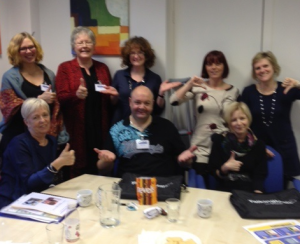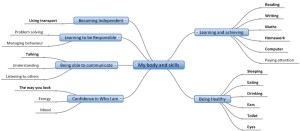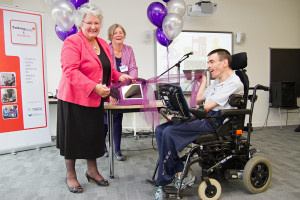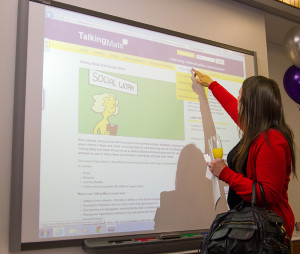Thank you Joan and Sally for the fantastic hospitality and inspiring 2 day accredited train the trainer course at Stirling university.
I cant wait to carry out our first session with all of the fabulous advice and support materials you have given us. Talking mats can reopen doors to communication that others may fear were closed for ever.
I was so lucky to meet a group of lovely people on the course, who also share the same enthusiasm for using Talking Mats. It is absolutely fantastic to be part of something that is world wide and getting bigger, long may you reign and long live Talking Mats.
Anthony Howe, Assessor/Tutor/Internal verifier
Training and Development Team, Adult Social Care
Tyne and Wear
During the final stages of developing Digital Talking Mats, we invited some people with aphasia and their partners to come and try it out for us. I spent some time talking to Matthew, who has severe global aphasia and dyspraxia. Matthew loves having a chat, but relaxed conversation can be a challenge because Matthew finds it difficult to generate language and sometimes his yes/no responses get mixed up. I used the ‘activities’ topic with Matthew to have a chat about the things he likes (and doesn’t like) doing. Matthew found the Digital Talking Mats easy to use and quickly gave me his views about activities. Using the i-pad made the conversation feel very natural, and Matthew was able to convey his sense of humour – when I asked him about Church; Matthew started to sing the Funeral March! We had quite a laugh about this, and it turned out that at the moment, Matthew really only goes to Church when there is a funeral. Matthew was also able to tell me about things that he finds difficult since his stroke, such as reading and doing DIY. During our conversation, I was struck by how equal the conversation felt. Matthew was able to express his views without feeling pressurised to think of words. I was able to ask Matthew open questions without worrying that I might not understand his responses. Using Talking Mats on the i-pad was easy and relaxed. I could imagine using it with Matthew to have a chat over coffee or at the pub. Perhaps we should think of some conversational symbol sets?
To see Matthew using the app, click here
Attending one of our standard training courses will:
- Provide you with a range of practical tools and models that will help you evaluate a person’s ability and their level of support required
- Give you a holistic framework to support people with communication disability
- Build your confidence in using Talking Mats
- Encourage your creativity in using and applying Talking Mats in different situations such as goal setting, sharing views, supporting disclosure, enabling decision making…..the list is endless!
You can either
- Book places on our regular courses held in different venues across the UK
- Book a bespoke training for your organisation
- Participate in our 12 week online training course
However, you cannot train others unless you have completed and passed one of our residential ‘train the trainers’ courses. We put significant emphasis on our accredited training because without it, the quality and integrity of the Talking Mats framework is diluted and damaged.Talking Mats is based on extensive research and although it may appear simple, there are many complex layers involved in using it and we need to be confident that trainers have an in depth knowledge and understanding of these.
In order to apply to become a Talking Mats trainer you have to have completed the standard training (above), be experienced in using Talking Mats and fulfil the course requirements.
Intellectual Property
Talking Mats was originally developed at University of Stirling and the Intellectual Property is held by the University and Talking Mats Limited is assigned the sole rights to Talking Mats. Talking Mats is registered as a trademark. Only training that is sanctioned by us is recognised and anyone training others without being a recognized Talking Mats trainer is infringing Intellectual Property and copyright.
Signposting and sharing knowledge
We are of course delighted when people share their knowledge and experience of Talking Mats and signpost others to the website and resources.
We wanted to develop a tool that would give a holistic picture of how a child or young person feels about their lives at home at school and in their communities. We took into account the significant developmental changes that occur from 3 to 17 years and the influence of environmental and personal factors surrounding the child or young person.
We asked our artist to reflect the age and stage of the child in developing a symbol set for:
- Early years
- Primary and
- Secondary
The symbols are organised into three topics:
My Body and Skills: In this section you explore how the child is growing and developing by focussing on the functions of the body as well as skills that are emerging. You can gain an impression of how the child feels he or she is progressing physically, socially, cognitively and behaviourally.
What I do and my support: In this section you look at the child’s lived experience by asking about the activities they participate in, as well as how they feel about the support they receive.
My Wider world: The communities in which children grow up have a significant impact on the well-being of both children and families. In this section you look at the child’s wider world by exploring the impact of nursery or school as well as the support system available to them.
Talking Mats prompts you to cover the relevant topics for each age group you’re working with. You can help children and young people to see their personal strengths and abilities and take time to consider what their problem areas are.
The mind map below shows what is included in the Primary pack – What I do and my support.
If you want to read about how Talking Mats were used to help young people think about targets for their IEP read the 2012 research report.
If you would like the complete Consulting children and young people pack, covering Early years, Primary and Secondary then buy the silver resource which can be purchased either as an original or through a digital subscription.
By Dr Norman Alm, School of Computing, University of Dundee.
Have been thinking for some years – and having dialogues with Joan Murphy – about this : would it be possible to come up with a new type of AAC where both the non-speaking person and their communication partner(s) were equally in joint control of some sort of system? Imagine a touch screen which also could be controlled by switch input. A non-speaking person and their communication partner are both engaged with the screen and both equally making use of it to do … what ?
Don’t know at the moment, but there are several suggestions for ways to explore and develop this idea further. Talking Mats is one.
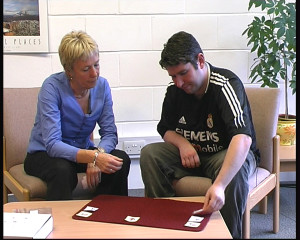
The purpose is to help the person with communication difficulties express their opinions, with the other participant being a facilitator. But notice what is not happening – a face-to-face interview. Instead both participants look away from each other and focus on the mutual task, manipulating the symbols on the mat to produce the communication. Much less stressful – and much more enjoyable and productive. Another example is the CIRCA system, which supports what is usually problematic communication between a person with dementia and a carer or relative. The support takes the form of touchscreen access to an engaging multimedia display of reminiscence material drawn from public archives. Again a potentially stressful and unproductive face-to-face encounter is converted into an enjoyable mutual activity that flows effortlessly. The design of each of these systems taps into something powerfully motivating. Talking Mats lets the person describe their emotional reactions to a subject, as manifested by the scale which organises the elements on display into a snapshot of that person’s individual feelings. CIRCA makes use of the one faculty still operative even in quite advanced dementia – the ability to recall long-term memories and enjoy sharing them.
Both these systems offer a structured communication encounter in which the structure has the effect of not restricting, but freeing up the communication. Crucially ( I would argue) both free the participants from the direct responsibility of keeping the interaction going and let them share that responsibility with a third agent.
Speech presented at the launch of new Talking Mats Resources
Hello everyone, my name is Greig McMurchie and I would like to take the opportunity to welcome you all here today. If I look familiar it may be because you recognised me from the original talking mat video, where I had a cameo appearance with the lovely Joan murphy of course that was over ten years ago, and back then I was much younger and better looking. Joan however is still as lovely as the day I met her.
As you can see, I have been involve in talking mats for many years now, ever since Joan asked me to help her trial a new communication system, that she and her colleague Lois had been developing. My initial thoughts were wow, this sounds really complicated and I was a little bit scared. But I had known Joan since I was little and I really wanted to see what this new Communication system was all about.
When Joan came to visit me at that Dundas day center, all those years ago, all my fear quickly disappeared, it was really easy. I was able to have my say, and because it was visual I could change my mind also. I began using talking mats to share my views, opinions and wishes, and before long this system was helping me to make life Changing decisions, such as what I wanted to do with my life once I had finished my college course. In fact you could argue that I am where I am today because of talking mats. And I like to say I wouldn’t have it any other way.
Anyway, that was away back then, and times have move on. About four weeks ago Joan and Lois came to Upper Sprinlands to visit me, and of course show me their wonderful bran new talking mats app. My initial thoughts were this sound fantastic, and when they arrived we had a wee chart and they explained what they had been doing.
I don’t know about everyone else, but when I was a kid a tablet was something you took if you were not feeling too well, an android was a character from a computer game and an apple was something you gave to your teacher to butter them up if you forgot to do your homework. But today all this modern technology is making it easy for everyone to engage creating doorways to all kinds of wonderful stuff. And boy can I say this new talking mats app is all kinds of wonderful.
So after we chatted I got to have a wee play with the new app, I couldn’t believe how easy it was, you were able to just move the pictures around and place them were you want them on the screen. The New picture sets are fantastic, they are bright colourful and easy to understand. I also like the way you can enlarge the picture to make it easier to see. And of course the fact that it come already to use. You can even take a photograph and send it to yourself by email. No more printing, cutting out and Velcroing, no more hunting for the camera only to realize the batteries are flat and you can’t use it anyway. Everything is just nicely packaged. And the fact that it can be used not only on an Ipad but also on a computer makes it even more accessible.
Dare I say I personally felt the new App for me was even easier than the old system; it is quicker, fun and very cool? Now I just need to persuade Upper springland to Purchase a copy or twelve.
Thank you talking Mats
(Speech at the Launch of the New Talking Mats Resources )
On Thursday 12th September Talking Mats we had a great evening as we launched:
- First version of Digital Talking Mats
- New Children and Young People’s resource
- New Health and Well-being resource
- New symbols
- New website
Over 80 people attended the event which took place at the beautiful Stirling College Campus. The speakers gave funny and heart warming short talks about their involvement with Talking Mats.
We were honoured to have Greig McMurchie and Anne McGuire MP to do the official ribbon pulling launch.
Kirsty and Joan demonstrated how to use the app and after this guests mingled and explored the app and the new website.
One of the things I love about Talking Mats is that it can be used by all agencies. When thinking about the rationale behind GIRFEC the main focus is to encourage professionals to work together. It is so refreshing to have a resource that is recognised and used across the agencies.
It is not necessary to have written reports with names of assessments or measures that are a mystery to each other. Talking Mats uses visuals to capture feelings and views. The reporting of those views can be understood by children, parents and professionals.
In developing our new resource we listened and responded to a wide range of professionals. We have researched the Well-being indicators and have provided a tool to give an overview of the issues in the lives of children and young people.
Our vision is to provide a tool to listen to and capture children’s voices. We have a responsibility to be open and realistic about how we respond to what they tell us. Taking time to listen means we need to take time to respond.
We hope that Talking Mats will improve understanding throughout the whole GIRFEC team as we seek to get to the heart of what matters to the child. Margo Mackay
(more…)
Theme 1 from Talking Mats Seminar: How do we vary the top scale?
One of the key skills in using Talking Mats is getting the top scale to reflect the question that you are asking and to be consistent.
WRITE IT DOWN SO YOU CAN STICK TO IT!
The following range of 3 point top scales have been suggested:
like – unsure – dislike
managing – need some help – not managing
very important – quite important – not important
really good at – getting better at – not good at
want – sometimes want – don’t want
calm – unsure – anxious
can do it myself – need a little help – need a lot of help
very easy – quite easy – hard
It was suggested that a way of dealing with a negative topic such as ‘anxiety’ or ‘pain’ was to use a quantitative top scale such as:
a little – some – a lot
Or you could ask what strategies make your pain
better – stays the same – worse
In some situations where the person has an acquired disability, it may be best to do 2 mats, one about liking and another about managing. It was suggested that adapting the mid point to reflect potential loss of skills might be useful:
like – like but can’t do it now – don’t like it
More recently we have found that the following wording works very well for lots of people and situations:
going well – sometimes – not going well
We are about to launch a digital version of Talking Mats which uses our brand new images, specially designed by a leading comic artist. We are currently in the testing phase to check how it is received by different client groups and professionals and to iron out any glitches.
We are planning to launch a free taster version first.
Following this there will be a Lite version with 2 full symbols sets ( £5.99) and then a subscription model with many more symbols sets and lots of additional functionality. It will also be available for Android.
The final version will be launched on 12th September.
If you would like to be kept informed of this exciting development please send an email to info@talkingmats.com
 Online training login
Online training login 

